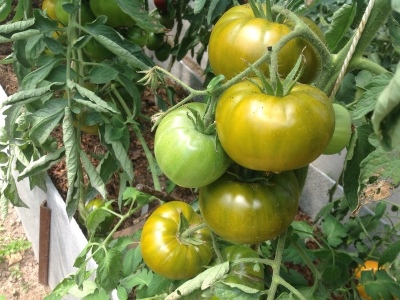
- Authors: Andreeva E.N., Nazina S.L., Ushakova M.I. (LLC Selection and seed-growing company "Tomagros")
- Year of approval: 2004
- Category: grade
- Growth type: indeterminate
- Appointment: fresh consumption
- Ripening period: early
- Ripening time, days: 95
- Growing conditions: for open ground, for film greenhouses
- Bush size: undersized
- Bush height, cm: up to 100
Many varieties of garden crops have unusual names. The Swamp tomato is a prime example of such a plant. However, it still deserves the closest attention.
Breeding history
The work on the variety was carried out in the selection and seed-growing company "Tomagros". The breeding project was carried out by Andreeva, Nazina and Ushakova. Permission for mass cultivation was granted in 2004. At the same time, the culture was entered into the State Register.
Description of the variety
The bushes near the Swamp are not high. They can grow up to a maximum of 1 m. Large green leaves of this plant are characterized by weak corrugation. It is worth remembering that the Swamp is an indeterminate variety. It is suitable for both free ground and greenhouses.
The main qualities of the fruit
Green unripe berries have a dark green area in the area of the stalk. Ripe tomatoes will also have a green color, but pink or yellow inclusions are found. The weight of 1 fruit can vary from 150 to 245 g. These are flat-round tomatoes with mild ribs.
Taste characteristics
In general, the Swamp tomato is sweet. However, a certain sour note is always present in it. The pulp of the fruit is always tender and pleasant. The harvested crop will have to be consumed mainly fresh, since its storage is very limited.
Ripening and fruiting
Swamp is a typical early tomato. After he throws out the green shoots, on average, it will take 95 days to form the finished berries. In greenhouse conditions, the harvest period is June-September. When cultivated in open ground, the first fruits can usually be obtained in July. Of course, the actual weather can greatly affect these times.
Yield
The collection reaches 5.4 kg per 1 sq. m. But this is only an average statistical indicator, which will not be difficult even for inexperienced gardeners to reach. It only takes a minimum of diligence. In greenhouses, productivity is on average higher than outdoors.
The timing of planting seedlings and planting in the ground
If you plan to grow bushes in a warmed place, you need to sow seeds in seedling boxes in mid-March. For cultivation in open land, you need to wait until the end of March - early April. Accordingly, disembarkation time usually comes at the beginning and at the end of May. In some cases, taking into account the weather, it is required to shift such dates by several days. But it is hardly worth delaying too much.

Growing tomato seedlings is an extremely important process, because it largely depends on whether the gardener will be able to harvest at all. All aspects must be taken into account, from seedbed preparation to planting in the ground.
Landing scheme
In the greenhouse, you need to plant 2 tomato bushes per 1 sq. m. In an open garden, you can add 1 more bush in the same area. Of course, experienced gardeners can adjust this to suit their own needs. It is necessary to form plants in 1 stem.

Growing and care
It is hardly possible to grow a swamp without pinching and garter work. It is better to time the landing at the time when the ground is thoroughly warmed up. Digging the soil has been recommended since the fall. At the same time, the seat is fed with humus and ash. New digging is recommended just before disembarkation.
The Swamp should be watered daily. Better to do it in the afternoon, not in the morning. Passing is carried out as new shoots form. The first feeding is carried out approximately 20-21 days after planting at the main place of growth. Experts note that the alternation of organic matter and mineral mixtures is the most productive; foliar feeding with boron-based formulations is also encouraged.
Sometimes leaves wither and turn yellow. Usually this problem is resolved by activating watering. Irregularities in the shape of plant parts may indicate a lack of nutritional components. The same is often expressed in the growth of roots directly on the stem. Operational feeding will eliminate one and the other pathology almost always.




A plant needs different micronutrients at each stage of growth. All fertilizers can be divided into two groups: mineral and organic. Folk remedies are often used: iodine, yeast, bird droppings, eggshells.
It is important to observe the rate and period of feeding. This also applies to folk remedies and organic fertilizers.


Growing regions
The variety is officially zoned in the Volgo-Vyatka region and the Middle Volga region. And also it can be cultivated successfully in:
Central Black Earth Region;
various regions and republics of the North Caucasus;
the center of the European part of Russia;
regions of the north and northwest of the Russian Federation.
Review overview
The Swamp tomato has a pleasant taste. However, cracking and a high susceptibility to disease are noted. Many people like the originality of the color. In this case, however, there are complaints about a relatively low yield. In general, the compliance of the culture with the declared parameters is noted.

























































































